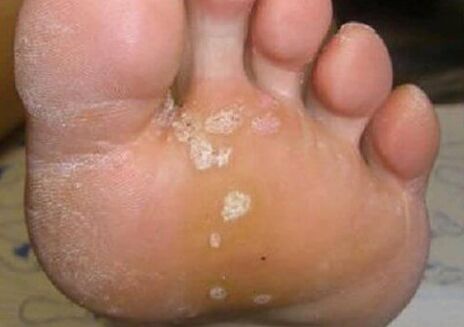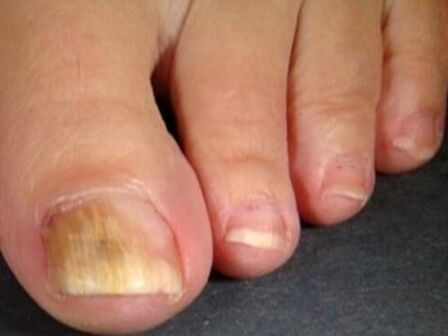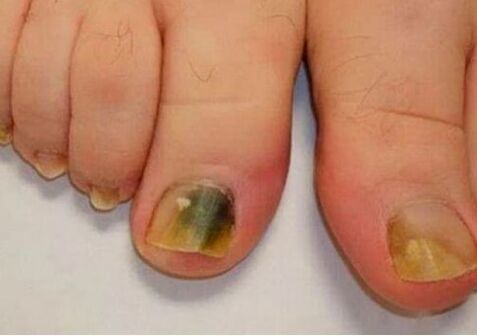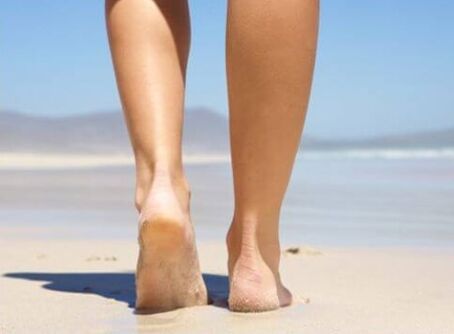Redness, peel of the skin on the legs, the appearance of cracks between the fingers, the ulcers in the legs, a change in nail condition: loss of shine, common pink shade, thickening of the plaque - these and other signs indicate the development of a fungal infection. Any fifth resident of the land is ill with mycosis. Therefore, you need to know how the fungus looks and behaved standing, what causes it leads to its appearance and how to treat this unpleasant disease.

Reason
In most cases, mycosis infection comes from a person to a person directly or through the surrounding objects. Favorable conditions for fungal reproduction are fever, moisture. Disputes can also maintain durability in a dry state, after poor processing of the quality of manicure tools.
The main reasons for the disease include:
Fungal diseases in humans develop faster against the backdrop of functioning features, as well as changes that lead to immune suppression, low local blood changes, in the skin condition. The reasons from the body are as follows:
Types of pathogenic fungi
The fungi in the human body feed on protein - keratin, elastin, collagen, dividing them with enzymes: keratinasis. The localization of mycosis depends on the activity of keratinase and the ability to digest different types of keratin.
The foot mycosis causes the following types of fungi:
Fungal skin lesions

From myth to the legs, skin lesion during psoriasis (sometimes called dry fungus) - red peel plates and a tendency to join the surface. Such elements are often found on the knees, feet. This disease is not associated with a fungal infection.
The manifestations of the fungus of the foot are conditionally divided into four main forms. The Convention is in a combination of clinical signs and the possibility of passing from one to another.
In an interiginous form, the skin is suffered in the interdigital spaces. The skin fungi manifest in the form of itching, burning, it is associated with an unpleasant odor. Often the infection affects the foot from intervals between 3 and 4, 4 and 5 fingers. The skin turns red, saturated with moisture, wounds, crying areas appear between the fingers. These signs develop independently or against the backdrop of an existing squamous shape.
Exactly! For typical interigenous lesions, the adhesion of a secondary bacterial infection that exacerbates the disease. Bacterial, mycotic eczema develops with the formation of a rash not only in the legs, the inflammatory elements appear on the ankle, lowering.
The advanced squamous-hyperkeratotic form looks like the usual massive corn in the only cracks. Initially, mynemous myce my skin can attract attention with dryness, peel of the skin of the legs, severe corn on the heel. People consider such symptoms an individual trait and do not turn to a dermatologist. Skin lesions can accompany itching, burning. If you look at the photos of the fungus in the legs with this form of mycosis, you may notice deep cracks in the background of a thickness (and, as it was, shod in the rock) of the skin of the feet. Such manifestations are painful. The squamous shape is characterized by the inclusion of nail plates with their destruction, a delay behind the nail bed.
Manifestations of the double (vesicular) shape of the foot fungus are rare. The main symptom of the disease is the formation of bubbles with a thick shell and transparent content. They are located on the single side of the foot, fingers as single or drainage formations. Then the bubbles open with the formation of erosion with purulent crust around the edges. Complications of vesicular lesion include:

The deleted shape of the fungus in the legs is characterized by minimal lesions, so it is not easy to recognize it. Main signs: the appearance of the intestinal peel, the formation of microcirculation between the fingers, discomfort, burns. With a long course, the nail plate is included.
Nails
Onychomycosis appears as a result of the fungus of the skin on the fingers, feet, in the absence of attention to the problem and adequate treatment.
The first symptoms and signs of onycomycosis can also pass unnoticed. You should contact the nail fungus on the foot and contact a dermatologist at:
There are different classifications of onycomycosis. With the appearance of the nail plate, they are divided into:
According to the localization and degree of damage to the nail plate, the following types of onychomycosis are distinguished: distal; side; mixed, proximal; Total; surface.
Loss of candidacy
Separately, damage to the genus Candida must be considered. These pathogenic fungi provided deeply (affect the internal organs) and superficial mycos (dermatomycosis, onycomycosis). Under normal conditions, human immunity suppresses the suppression of the reproduction of this fungus and a mass infection does not occur. Therefore, Candida activity manifests itself with significant disorders in the body of body protection and requires a thorough examination to establish the cause of immunity. The first signs of infection are difficult to distinguish from damage, frost.

Damage to the fungus in the foot develops as follows:
Troubleshooting
The diagnosis of fungi in the leg includes:
Treatment
The fungus on the foot requires immediate treatment that a dermatologist (or mycologist) will prescribe. You can perform tasks on outpatient basis.
How and how to treat the fungus in the leg depends on a number of conditions:
Treatment of fungi in the leg takes a long time and its main purpose is to disappear the clinical and laboratory signs of the infection. An incomplete course of therapy leads to restoring the disease.
Drug therapy
Drug treatment is performed using antifungal drugs that not only destroy mycosis but also help remove manifestations of inflammation and eliminate secondary infection.
They are divided into:
In the initial phase of a fungus infection, drug therapy is limited to the appointment of local funds. With ordinary mycosis, with a severe course, systemic antimycotics are required.
Treatment with popular remedies.
There are many recommendations on how to get rid of fungi to the feet of popular and household remedies. Most mean external use, and some - inside. However, you should not drink and apply suspicious compositions on your feet in the hope of bringing neglected mold. Such popular methods can harm health.

Exactly! The most common and effective home of the home for the fungus is the feet for the feet with salt, soda, essential oils. These therapeutic procedures prepare the legs and nails for the application of the drug.
Surgical treatment
With a massive damage to the fungus, the nail plates will have to be removed. This method is safe and there are virtually no contraindications. An alternative to surgical manipulation - the use of pastries and ointments to soften the nails followed by removal.
Laser
The use of a laser to combat onycomycosis is based on the heat and destruction of the fungal spores with a directed beam. This technique allows you to quickly cure onycomycosis, safe and applicable to patients who are contraindicated in systemic treatment.
Treatment of dermatomycosis
To begin treatment of fungi, local antifungal agents are used in the legs. If there is no improvement of the condition after a 2-week treatment course, an antimycotic agent is required. In case of severe damage, skin fungi requires the recipe of systemic drugs. Therapy continues until the full elimination of infection.
The treatment of onycomycosis
Local medicines have been prescribed to eliminate the initial manifestations of nail fungus. Mycosis with a lesion of more than 2/3 of the nail area, which includes the growth area, distribution on other plates - an indicator for taking systemic medicines. Onychomycosis with massive destruction of nail plates begin to be treated with surgical removal of the affected nail tissue. This method provides access to the focus of the infection.
Important!
The treatment of onycomycosis is performed before growing healthy nails and can last up to 12 months.
The appearance of fungi in the foot can be caused by various reasons. An attentive attitude towards your health will help recognize the disease in time and begin treatment.



























